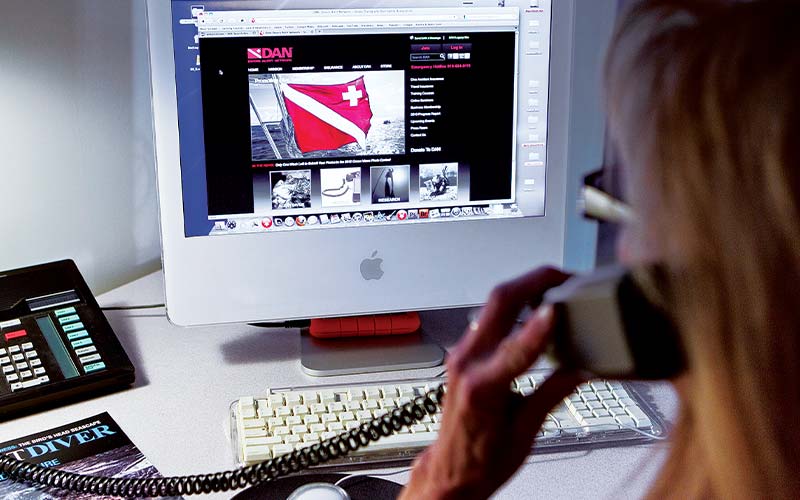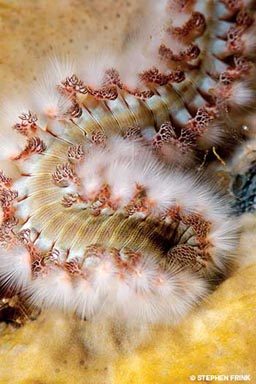Q: I have recently been diagnosed with gallstones. Can I continue to dive?
A: According to the National Institutes of Health, some 700,000 individuals undergo gallbladder surgery each year. The gallbladder is a hollow organ closely associated, both physically and functionally, with the liver. Its primary purpose is to collect and concentrate bile, which is then introduced into the upper intestine to assist with digestion. Gallstones are commonly made up of cholesterol or bile salts and range in size from very small flakes to more than 2 inches in diameter.
For divers, the primary concern with gallstones is the potential for acute symptom onset while underwater or in a remote location. When symptoms occur, they often include intense pain in the upper right quadrant of the abdomen and may be accompanied by nausea and vomiting.
Diving during an acute attack or when an acute attack is possible is not recommended. Individuals who have pre-existing gallstones or experience intermittent cramping or pain under the right side of the ribcage may want to strongly consider being evaluated prior to diving or remote travel. Surgical removal of the gallbladder (cholecystectomy) and stones is done routinely as a laparoscopic (using small incisions and a camera) outpatient procedure. Patients are usually cleared for a return to diving following adequate healing and clearance by their physician.

Q: I read on the Internet …
A: DAN® frequently receives emails and phone queries that start off, “I read on the Internet ….” Unfortunately, the information garnered often lacks a reputable source. We live in a wonderful age in which answers abound and information is readily available. In the scientific and medical communities, source documentation, validation and peer review are considered necessary criteria for publication. DAN uses information from scientific and medical literature such as journal articles and textbooks as a basis for our responses. Our sources may also include seminars, workshops and case reports from researchers around the world. DAN responses, therefore, stem from published scientific literature or represent the prevailing expert opinion from our network of physicians and researchers.
Recreational divers connect with DAN at various regional and national dive shows as well as through Alert Diver magazine, AlertDiver.com, dive shops, webinars and local dive events. What the recreational diving public does not see and may not be aware of is DAN’s attendance at medical conferences, workshops and other academic and professional events. DAN attends meetings of the Undersea and Hyperbaric Medical Society (UHMS), American College of Emergency Physicians (ACEP), Wilderness Medical Society (WMS), International Association of Dive Rescue Specialists (IADRS), European Underwater and Baromedical Society (EUBS), South Pacific Underwater Medicine Society (SPUMS), American Academy of Underwater Sciences (AAUS) and other national and international conferences. Attending these events allows DAN to keep abreast of the active research in dive medicine and support those efforts as a sponsor or research partner. Working at all levels of the diving and medical/research communities keeps us on the cutting edge, striving toward our vision of making every dive accident- and injury-free.
Q: While diving I encountered a sea urchin and now have a bunch of spines sticking out of the fleshy part of my thumb between the wrist and palm. What should I do?
A: Puncture wounds create an ideal environment for local infections as well as for systemic infections such as tetanus. Never neglect puncture wounds, and be sure to thoroughly clean the wound with soap and water as soon as possible. Have them evaluated by a doctor at the first sign of concern, and make sure your immunizations are up to date.

Beyond the pain of the puncture, systemic symptoms occasionally occur and may include nausea, syncope (loss of consciousness), ataxia (loss of coordination), muscular cramps, generalized weakness, paresthesias (altered sensations), even respiratory distress. But these serious symptoms are very rare. Typically these wounds are more of an annoyance than a real threat.
In the rare event that urchin spines contain toxins, their effects, such as pain, can be minimized with the application of hot water. Most of these toxins are thermolabile, meaning they can be broken down with heat. Hot-water immersion is an important part of first aid; the water should be around 110°F to most effectively relieve symptoms. Water that is too hot may harm healthy tissue, so always test the temperature on yourself first if treating someone else — local skin reactions may alter an injured person’s ability to discern if water is too hot.
It is important to note that some species have very persistent pigments, and those black dots in your skin may actually be pigment rather than actual spines. In most cases it is easier to assess whether or not spines are still present once the initial swelling has resolved. The decision about whether or not to remove spines should depend on several factors: location, pain with movement, joint or tendon involvement, signs of infection and allergic reactions. The same way an egg is much stronger if you squeeze it from top to bottom but fragile if you squeeze it from the sides, sea urchin spines can be really hard at the time of penetration but awfully fragile when you try to remove them. In some cases localization by X-ray may guide extraction efforts.
Foreign bodies such as spine fragments can cause reactive granulomas, which are roughly spherical masses of immune cells that encapsulate foreign bodies. This is a normal immune response that attempts to wall off substances that are perceived as foreign until the granuloma can either digest them or eliminate them with drainage of pus through an opening in the skin. This can take anywhere from a few days to several months.
Prevention is the goal. Before your next dive consider strategies like improved buoyancy control. If your diving skills are rusty or you think an update would help, consult your local dive shop about buoyancy specialty training.
Q: I have inflammatory bowel disease and wonder if I should go on a dive trip.
A: Inflammatory bowel disease (IBD) is a chronic condition that causes inflammation and sometimes ulceration of the bowel. The two most common forms are ulcerative colitis and Crohn’s disease. As the name implies, ulcerative colitis is limited to the colon. Crohn’s disease, on the other hand, can involve any segment of the gastrointestinal (GI) tract, from the mouth to the anus. Some individuals are genetically predisposed to IBD; those affected are also at increased risk of GI cancer.
Ulcerative colitis and Crohn’s disease also have several non-GI manifestations, which include arthritis, iritis and episcleritis (inflammation of the eyes), skin lesions, sclerosing cholangitis and pericholangitis (inflammation of the bile ducts and surrounding tissues). Systemic symptoms are common in IBD and include fever, sweats, malaise and joint pain.
Commonly affecting people in the 20- to 40-year age group, IBD complications include anemia (low iron), electrolyte imbalance, impaired nutrient and fluid absorption, liver disease and dehydration. Mild cases with only occasional symptoms may be treated with medication, but severe cases may involve surgical removal of the affected bowel.

Most people with IBD have a good understanding of their condition and their physical capabilities. Diving is only recommended if the condition is in remission or if symptoms are mild and well controlled. Divers with IBD who travel to remote areas or go on liveaboards should carefully consider the logistics if an acute attack were to occur. In those situations, treatment may be complicated or delayed. Divers with active symptoms of IBD should not dive.
Q: A bristleworm startled me by climbing onto my hand while I was taking a photo. Should I be concerned?
A: Bristleworms are spread widely throughout the world with species in all oceans. They are usually quite colorful and appear to many observers as a kind of caterpillar of the sea. Their length ranges from a few millimeters to around 8 inches. Symptoms of contact with a bristleworm may include itching, inflammation, redness, burning and numbness. Treatment is symptomatic, which means its aim should be to directly address whatever symptoms occur. Adhesive tape can help remove any bristles that remain on the skin. Clean the affected area with soap and water, and keep it dry. Over-the-counter antibiotic salves and anti-inflammatory creams are commonly used remedies. Should you develop any blisters, do not puncture them. Just let them dry out.
© Alert Diver — Q1 Winter 2012